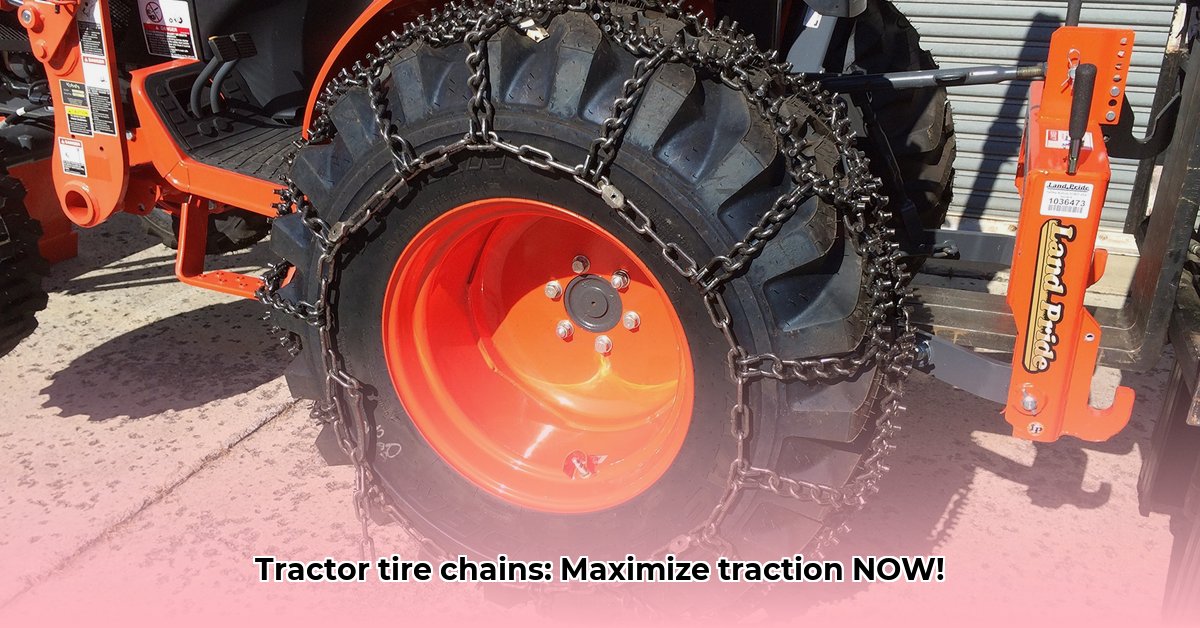
Understanding 11.2-24 Tractor Tire Chain Sizing: Precision is Paramount
The numbers "11.2-24" specify your tire's dimensions. "24" denotes the wheel's rim diameter (in inches), while "11.2" typically indicates the tread width. However, this can be misleading, as newer tires with a 24" diameter might have a wider rim width, leading to confusion with the 12.4x24 standard. The 12.4 represents a wider sidewall measurement. Accurate measurement is crucial for a proper fit. Never assume – measure your tire's width and rim diameter directly to avoid purchasing incompatible chains. A slight mismatch renders the chains ineffective and potentially dangerous. Consult your tire's specification if unsure. For repair parts, check out our repair guide.
Diagram: (Insert diagram showing how to measure tire width and rim diameter)
Sizing Chart: (Insert sizing chart correlating tire dimensions to appropriate chain sizes)
Purchasing 11.2-24 Chains: Pairs or Singles? A Cost-Benefit Analysis
Buying chains in pairs or individually presents a trade-off between upfront cost and long-term flexibility. Purchasing pairs is often cheaper upfront and simpler; you get two chains ready to go. But, if only one chain breaks, you're replacing a perfectly functional chain. Buying individually increases upfront costs but offers flexibility and reduces waste if only one chain needs replacement. The best approach hinges on your budget and typical chain replacement frequency. For infrequent replacements, pairs are efficient; for farms operating in severe conditions that lead to frequent damage, buying singles might be more cost-effective in the long run.
Chain Types and Specifications: Optimizing Traction for Diverse Conditions
Different chain patterns (e.g., diamond, ladder) provide varying traction characteristics. Diamond patterns excel in mud and deep snow, offering superior grip in extreme conditions. Ladder patterns are generally more durable and better suited for packed snow or ice. Chain strength is also critical, indicated by a grade system. Higher grades denote greater strength, ideal for heavier loads and challenging terrains. However, excessively strong chains may be unnecessary and could put additional strain on your tractor and tires. Select the chain type and strength that best suits your terrain and workload. Over-engineering isn't cost-effective and may cause undue wear and tear on your equipment.
Installing 11.2-24 Tractor Tire Chains: A Step-by-Step Guide
Correct installation ensures safety and optimal chain performance. Follow these steps meticulously:
- Safety First: Park on a level surface and engage the parking brake.
- Chain Positioning: Carefully place the chain around the tire, ensuring even distribution.
- Securing the Chain: Attach the connectors securely, ensuring a snug but not overly tight fit.
- Tension Adjustment: Adjust for even tension around the entire tire.
- Test Rotation: Rotate the wheel to confirm proper fit and prevent binding.
- Final Check: Examine before driving to ensure no loose links or potential hazards.
Pro Tip: Ensure chains are properly seated and don't contact the tractor's frame or other components.
Maintaining and Storing 11.2-24 Chains: Extending Their Lifespan
Proper maintenance extends chain life and prevents costly replacements. Clean chains thoroughly after each use, removing mud and debris. A light application of chain lubricant protects against rust and corrosion. Store chains in a dry, clean environment away from direct sunlight and moisture. Organized storage prevents tangling and damage. Don't just dump them in a pile.
Troubleshooting Common 11.2-24 Tractor Tire Chain Problems
Addressing common chain issues promptly maintains operational efficiency:
- Loose Chains: Check and re-tighten chain tension.
- Damaged Links: Repair or replace damaged sections immediately.
- Uneven Wear: Inspect tires for proper inflation; uneven wear might indicate tire problems.
- Difficult Installation: Ensure correct sizing; improper fit will lead to problems.
Inventory Management Strategies for Retailers: Optimizing Stock Levels
Retailers must manage inventory efficiently. Consider these approaches:
- Demand Forecasting: Utilize tools and historical data to predict sales and optimize stock levels.
- Cross-Chain Ranges: Stock a range of cross-chain lengths to accommodate different tire sizes and conditions.
- Sales Data Analysis: Regularly analyze sales data to anticipate demands and optimize purchasing patterns.
- Inventory Management Software: Consider implementing software solutions to manage inventory levels, predict demand, and streamline ordering. These tools minimize stockouts and overstocking, leading to improved efficiency.
Conclusion: Maximizing Traction and Safety with the Right 11.2-24 Chains
Selecting and using appropriate 11.2-24 tractor tire chains is crucial for safety and optimum traction. Accurate measurements, appropriate chain selection, thorough installation, and regular maintenance ensure optimal performance and extend chain lifespan and prevent costly repairs and downtime. Prioritize safety and always follow manufacturer's instructions.